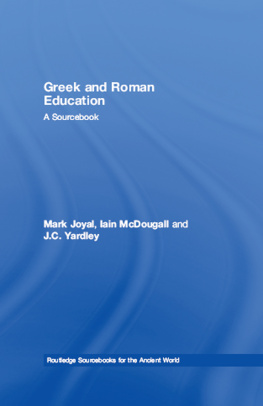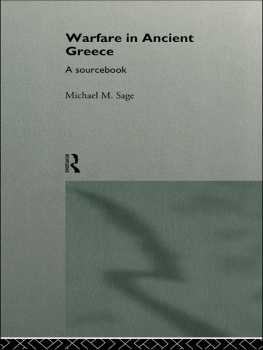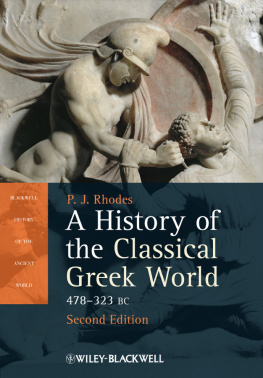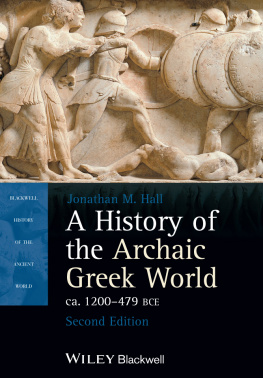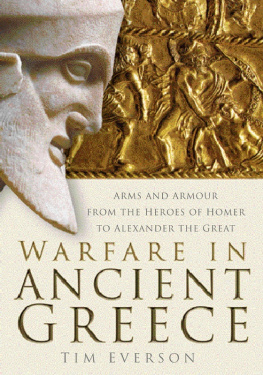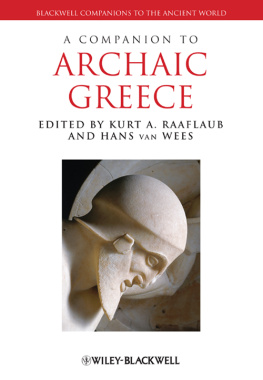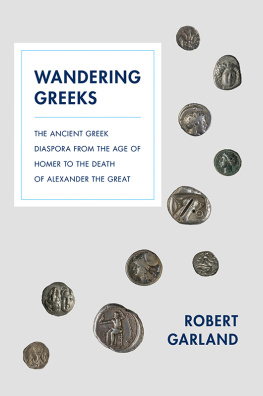Blackwell Sourcebooks in Ancient History
This series presents readers with new translations of the raw material of ancient history. It provides direct access to the ancient world, from wars and power politics to daily life and entertainment, allowing readers to discover the extraordinary diversity of ancient societies.
Published
The Ancient Near East
Edited Mark W. Chavalas
The Roman Games
Alison Futrell
Alexander the Great
Waldemar Heckel and J. C. Yardley
The Hellenistic Period
Roger Bagnall and Peter Derow
Ancient Greek Religion
Emily Kearns
Ancient Greece from Homer to Alexander
Joseph Roisman; translations by J. C. Yardley
In Preparation
Sexuality in the Classical World
Holt Parker

This edition first published 2011
2011 Blackwell Publishing Ltd
Translations 2011 John Yardley
Blackwell Publishing was acquired by John Wiley & Sons in February 2007. Blackwells publishing program has been merged with Wileys global Scientific, Technical, and Medical business to form Wiley-Blackwell.
Registered Office
John Wiley & Sons Ltd, The Atrium, Southern Gate, Chichester, West Sussex, PO19 8SQ,
United Kingdom
Editorial Offices
350 Main Street, Malden, MA 02148-5020, USA
9600 Garsington Road, Oxford, OX4 2DQ, UK
The Atrium, Southern Gate, Chichester, West Sussex, PO19 8SQ, UK
For details of our global editorial offices, for customer services, and for information about how to apply for permission to reuse the copyright material in this book please see our website at www.wiley.com/wiley-blackwell.
The right of Joseph Roisman to be identified as the author of this work has been asserted in accordance with the UK Copyright, Designs and Patents Act 1988.
All rights reserved. No part of this publication may be reproduced, stored in a retrieval system, or transmitted, in any form or by any means, electronic, mechanical, photocopying, recording or otherwise, except as permitted by the UK Copyright, Designs and Patents Act 1988, without the prior permission of the publisher.
Wiley also publishes its books in a variety of electronic formats. Some content that appears in print may not be available in electronic books.
Designations used by companies to distinguish their products are often claimed as trademarks. All brand names and product names used in this book are trade names, service marks, trademarks or registered trademarks of their respective owners. The publisher is not associated with any product or vendor mentioned in this book. This publication is designed to provide accurate and authoritative information in regard to the subject matter covered. It is soldon the understanding that the publisher is not engaged in rendering professional services. If professional advice or other expert assistance is required, the services of a competent professional should be sought.
Library of Congress Cataloging-in-Publication Data
Roisman, Joseph, 1946
Ancient Greece from Homer to Alexander: the evidence / Joseph Roisman.
p. cm. (Blackwell sourcebooks in ancient history)
Includes bibliographical references and index.
ISBN 978-1-4051-2775-2 (hardcover: alk. paper)ISBN 978-1-4051-2776-9 (pbk.: alk.
paper) 1. GreeceCivilizationTo 146 B.C.Sources. 2. GreeceHistoryTo 146
B.C.Sources. I. Title.
DF12.R65 2011
938dc22
2010025066
A catalogue record for this book is available from the British Library.
Illustrations
| The Toumba Building |
| Exekias Vase with Ajax and Achilles |
| A silver tetradrachm from Memphis, Egypt, 332-323 |
| A funeral scene on a Dipylon Vase |
| A griffin jug from Aegina |
| The settlement in Zagora, Andros |
| Selinus site plan |
| An Archaic bronze figurine of a young Spartan female, dressed as a runner |
| The Symposion of Five Cup, ca. 565 |
| A soldier on the frieze of the Vix Krater, ca. 530-520 |
| The Chigi Vase, ca. 640 |
| The statues of Harmodius and Aristogeiton |
| Ostraka with inscription: Themistocles, son of Neocles |
| A kouros |
| The Peithinus Cup: male couples |
| The Peithinus Cup: young men and women |
| The Eurymedon Vase |
| A banquet scene, Paestum, Italy |
| A Panathenaic oil jar |
| The Macron Cup with Triptolemus |
| The mound at Marathon |
| The Lenormant Relief of a trireme in the Acropolis Museum |
| Olympia, a reconstruction of a classical trireme |
| The battle plan of Salamis |
| Miletus city plan |
| Figure W22.1 | The Lysicrates monument |
| Plan of a mass burial in the Kerameikos |
| A Spartan shield from Pylos |
| Nolan amphora by the Micon Painter showing a Herm |
| The Spartan tomb in the Kerameikos |
| The Dexileus Monument |
| A Thracian peltast |
| A Boeotian federal coin |
| Eirene with Wealth (Plutus) |
| Messenes walls |
| A jurors token (pinakion) |
| A counterfeit coin |
| A Roman copy of Polyclitus, Doryphoros |
| A hydria by the Munich Painter with a domestic scene |
| The metal parts of a sarissa: spearhead, butt-spike, and connecting socket |
| Plan of an Olynthian house |
| Plan of the battle of Chaeronea |
| The Philippeum |
| A reconstruction of the face of Tomb II, Vergina |
| The Alexander Mosaic |
| The Porus medallion |
Maps
| Greece and the Aegean |
| Greek settlements in the west |
| The Athenian demes: Attica political organization |
| Xerxes expedition |
| The Long Walls |
| Pylos and Sphacteria |
| Ancient Sicily |
| Ancient Macedonia |
| Alexanders campaigns, 334-323 |
Preface and Acknowledgments
The aim of this book is to acquaint the reader with the main evidence for Greek history from Homer and the end of the Dark Age to Alexander the Great (ca. 800323 BCE). Although the editor hopes to have covered diverse political, social, and cultural aspects of Archaic and Classical Greece, he does not strive to be exhaustive or to provide a substitute for a textbook on the subject. Indeed, much of the volume deals with the Greek mainland and is less concerned with Greeks in the western Mediterranean. Similarly, the bibliography of modern scholarship at the end of each chapter does not aim to be comprehensive but is limited to works in English, with a clear preference for more recent publications. (Only the author and the year of publication are given in these bibliographical notes. Fuller details can be found in the References at the end of the book.) Finally, the selection of the evidence may at times reflect the personal interests of the editor. Yet an attempt was made to create a continuity of themes and processes by placing the evidence in a broader historical context and by linking various documents together. A companion website provides further evidence and explanations in addition to those offered here as well as links to relevant online sites.




